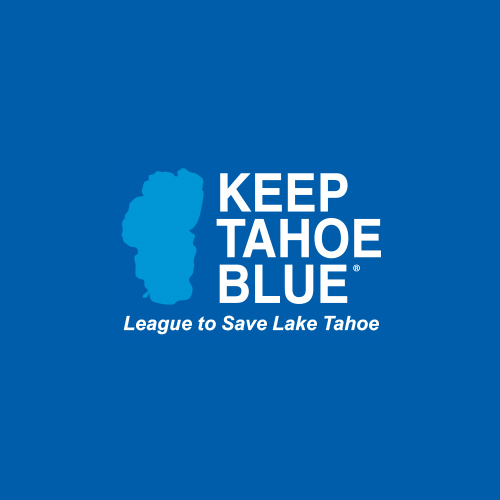Our advocacy, policy, and science experts keep a watchful eye on projects and plans that could impact the health and clarity of Lake Tahoe. We do this work through our three campaigns: Advance Restoration, Combat Pollution, and Tackle Invasive Species. Scroll down to read about a few projects we’re working on now.
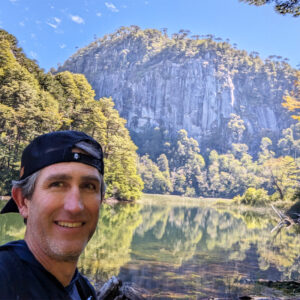
Field Notes from Chile
This month, the League’s Jesse Patterson is visiting South America to meet with, learn from, and share conservation lessons with members of Chile’s burgeoning environmental movement. This trip is the latest chapter in a relationship that stretches back to 2018. Keep an eye on the League’s blog for updates.
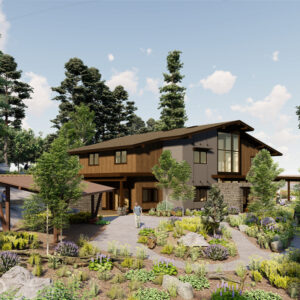
Your Input for the New Education Center
The League is excited to develop a new education center in our future home – a building we’re currently renovating in South Lake Tahoe (see the press release). The new education center is for you! Please let us know what features you’d like to see by completing this short survey.
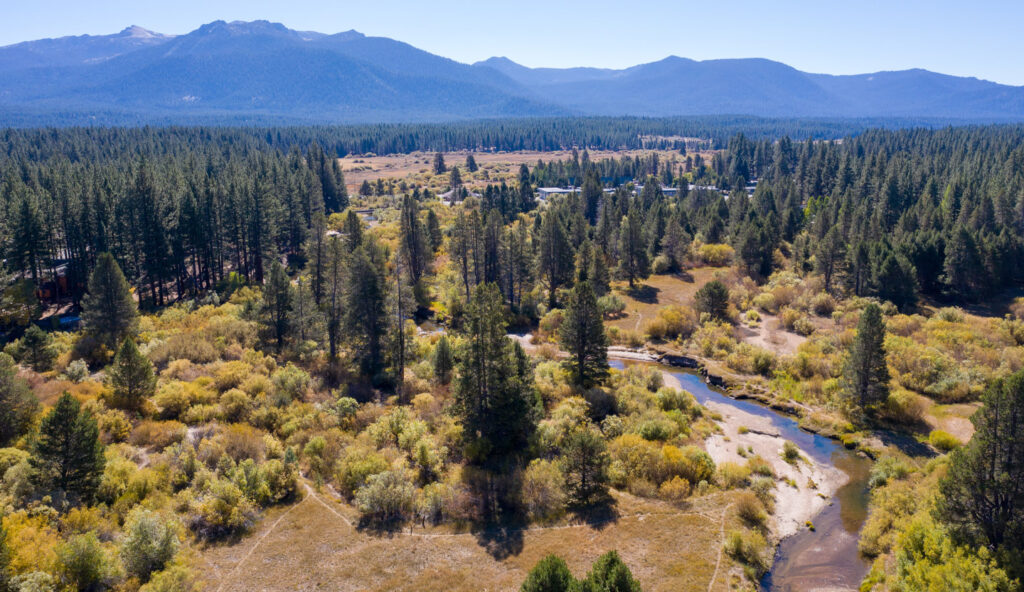
The Upper Truckee Marsh looking south toward Highway 50. Photo: California Tahoe Conservancy
Advance Restoration:
Historic Property Acquisition Underway to Restore the Upper Truckee River and Marsh
WHAT IS IT?
For decades, the League and other organizations have worked to put 31 acres of environmentally sensitive land along the Upper Truckee River in South Lake Tahoe into public hands so it can be restored to Keep Tahoe Blue. A Motel 6, parking lot, and restaurant building have sat in the river’s floodplain for decades, restricting connectivity of the Upper Truckee River ecosystem and handicapping the Upper Truckee Marsh’s ability to act as a natural pollution filter for Lake Tahoe.
Acquiring the 31-acre property places over 96 percent of the lower nine miles of the Upper Truckee River in public ownership. The river drains a third of the Lake Tahoe Basin’s land area, meaning restoration is key to protecting the Lake’s water quality and clarity. The property lies at the junction between other sensitive, publicly held lands: 560 acres of the Upper Truckee Marsh to the north and 206 acres of Johnson Meadow across U.S. Highway 50 to the south.
WHERE IS IT IN THE PROCESS?
Just days ago, the California Tahoe Conservancy announced they are acquiring the long sought after property with support from its funding partners – the League to Save Lake Tahoe, Tahoe Fund, California Wildlife Conservation Board, Tahoe Regional Planning Agency, and California Department of Fish and Wildlife.
WHAT’S NEXT?
In the coming years, the Conservancy will remove the 1970s-era motel and vacant restaurant and retire or transfer the property’s development rights and coverage to use for future redevelopment in town centers where impacts are easier to offset and development does not sit within a floodplain. The Conservancy will preserve or restore the surrounding mountain meadow and wetland habitat and work toward completing its multi-decade project to restore the Upper Truckee Marsh.
In the Upper Truckee watershed, projects have been completed over decades to restore streams, rivers, wetlands, floodplains, and wildlife habitat. This acquisition amplifies the value of past restoration projects and opens the door for closely coordinated ecosystem restoration and management efforts in the future.
WHAT IS THE LEAGUE’S POSITION? SUPPORT
Healthy, functioning wetlands act as a natural pollution filter for Lake Tahoe, preserving its famed clarity. For decades, the League has taken part in collaborative efforts to restore and improve the Upper Truckee Marsh and river habitat citizen using citizen science, public education, hands-on volunteer projects, and vocal public support. Our team has also consistently advocated to decision makers in Sacramento to ensure that acquiring this property remains a priority for the State. As this acquisition came together, the League to Save Lake Tahoe worked in tandem with the Tahoe Fund to support the Conservancy’s offer. We are delighted that we could help the Conservancy acquire the property and set it on a course to revitalization.
CLIMATE CONNECTION:
Tahoe’s marshes, meadows, and wetlands are Tahoe’s natural pollution filters, as well as buffers against the impacts of development. When healthy, they remove pollutants from waters flowing into the Lake, protecting the Lake’s clarity, water quality, and beauty for all to enjoy. This crucial project will make Lake Tahoe more resilient and better able to withstand environmental shocks from climate change, such as extreme storms, drought, and wildfire.
MORE INFORMATION:
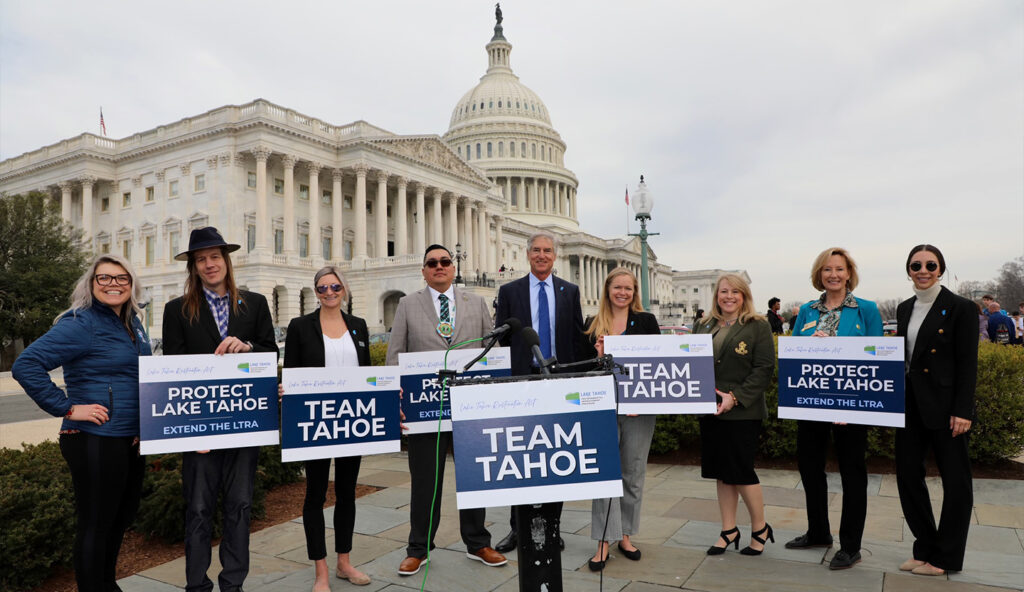
Advance Restoration:
Advocating in Washington D.C., Sacramento, and Carson City
WHAT IS IT?
Federal: Earlier this month, the League’s policy experts and board chair traveled alongside a group of almost two dozen leaders representing Tahoe interests to speak with federal lawmakers from both sides of the aisle on the Lake’s behalf. Their goal was to urge Congress to extend the timeline of the 2016 Lake Tahoe Restoration Act, a key piece of federal legislation that is the mechanism for delivering hundreds of millions of dollars for public agencies to implement critical environmental projects in Tahoe, such as wildfire readiness and ecosystem restoration.
The Act, which became law in 2016, authorized $415 million dollars for Tahoe. But as of today, only around one quarter of that amount has been appropriated. With the Act scheduled to expire at the end of September, the Tahoe leaders met with the federal delegation, their staffs, and other key decision makers to push for the Act to be extended for an additional decade, allowing time to receive the remaining funding authorized in 2016. Tahoe is undoubtedly a national treasure; we’re making sure it remains a national priority.
California: Just days after their trip to D.C., our policy team also coordinated a visit to Sacramento by the California Tahoe Alliance (CTA), representing 11 Tahoe organizations. Their goal was to press California decision makers to approve state funding to match and unlock dollars from the federal government and Nevada for Tahoe priorities, including climate change resilience and wildfire readiness.
Nevada: Also in March, the Nevada legislative committee charged with overseeing the Tahoe Regional Planning Agency met in Tahoe. Our staff helped lead a tour for members of the committee and provided comments on Tahoe’s transportation needs, which was the meeting’s focal point.
WHERE IS IT IN THE PROCESS?
Federal: In 2023, U.S. Senator Cortez Masto (D-Nev.) introduced legislation to extend authorization of the 2016 Lake Tahoe Restoration Act, which would keep available until 2034 hundreds of millions of approved but unappropriated funds for Tahoe. These funds will help finish crucial environmental work and build Tahoe’s resilience in the face of unprecedented impacts from climate change, including catastrophic wildfire. The bill was supported unanimously by Tahoe’s federal delegation in both houses of Congress, along with other Tahoe champions who added to the broad, bipartisan coalition of support. Now, the Lake Tahoe Restoration Act extension needs a hearing in the House of Representatives.
California: In the face of looming budget cuts, the CTA is urging the Legislature to preserve funding for Tahoe. That includes allocating $6 million to the California Tahoe Conservancy to leverage and match $10 million in federal funds appropriated through the Lake Tahoe Restoration Act. Those dollars would be used for important forest health work like fuels reduction projects. The CTA also supports SB 1088, which provides state matching funds for localities to upgrade their water systems in the wildland-urban interface for use in firefighting. Those upgrades could include installing new fire hydrants, storage tanks and emergency generators, and upsizing waterlines.
Nevada: The oversight committee will meet four more times this year and conclude by providing requests for legislation to be considered when the legislature is in session in 2025.
WHAT’S NEXT?
Federal: The League will continue building support among federal legislators in both houses and parties. Once the bill is extended a decade, our focus will turn to getting the funds appropriated, so dollars are delivered for environmental improvement projects in Tahoe.
California: The League and other members of the CTA are staying in close contact with state lawmakers to push our policy priorities across the finish line.
Nevada: The League will work with Tahoe Basin partners to identify needs that could be addressed through legislation.
WHAT IS THE LEAGUE’S POSITION? SUPPORT
Federal: For decades, the League has been a strong advocate and vocal champion for channeling federal funding to Tahoe. As a member of the Tahoe Partnership, alongside colleagues from the Tahoe Regional Planning Agency and Tahoe Chamber, we make numerous trips to Washington D.C. each year to lobby for Tahoe and ensure money makes it to projects on the ground. We would like to thank our elected officials for their commitment to Keep Tahoe Blue: Senators Catherine Cortez Masto and Jacky Rosen of Nevada, and Senators Alex Padilla and Laphonza Butler of California; Representatives Kevin Kiley, John Garamendi, and John Duarte of California, and Representatives Mark Amodei, Susie Lee, Dina Titus, and Steven Horsford of Nevada.
California and Nevada: Most often, access to federal dollars requires matching funds from the state(s) where the work is to be done, highlighting one reason our work in Carson City and Sacramento is crucial.
CLIMATE CONNECTION:
Federal, California, and Nevada: Funding from the Lake Tahoe Restoration Acts, combined with matching funds from Nevada and California, has enabled projects that make Tahoe better able to withstand the impacts of climate change – including extreme wildfire and drought – through forest management work and revitalization of ecosystems and their functions.
MORE INFORMATION:
- “Nevada, California leaders gather in D.C. to discuss importance of extending Lake Tahoe Restoration Act” – KUNR
- “Tahoe restoration efforts set to lose $301 million; state officials urge Congress to act” – Reno Gazette Journal
- “NV Oversight Committee addresses Tahoe Transportation Challenges” – KTVN2 News
- About the Lake Tahoe Restoration Acts
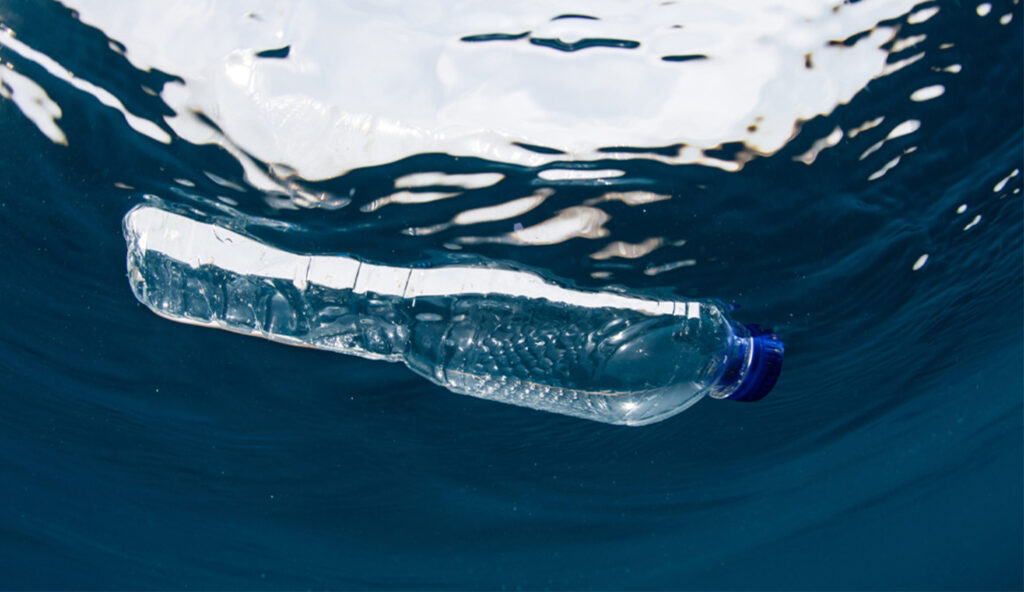
Combat Pollution:
Ban on Single-Use Plastic Water Bottles is Approaching
WHAT IS IT?
In October 2022, the South Lake Tahoe City Council passed an ordinance banning all single-use plastic water bottles under one gallon. This policy puts South Lake Tahoe among a small group of jurisdictions nationwide who have taken this bold action to combat a major source of plastic pollution.
The League is proud that our advocacy work helped contribute to the Council’s decision, just as it did when the City passed a plastic bag ban in 2013 and polystyrene (Styrofoam) ban in 2018. Statistics gathered during nearly a decade of Keep Tahoe Blue cleanups revealed that single-use plastic water bottles are a common and persistent type of litter found on Tahoe’s beaches, forests, and trails. Unless they’re removed, these bottles can break down into microplastics that threaten wildlife and enter the Lake’s blue waters where they are all but impossible to remove.
The ban does not affect the sale of plastic bottles over one gallon, nor boxed and canned water. In addition, Tahoe boasts some of the cleanest and best-tasting tap water in the country, which you can take advantage of by using refillable water stations around the Lake. We encourage you to Drink Tahoe Tap.
WHERE IS IT IN THE PROCESS?
The ordinance prohibits the sale or distribution of single-use plastic water bottles. It was designed to go into effect in two phases:
- At City facilities, permitted temporary activities, and special events starting on Earth Day 2023.
- From any store, restaurant or business in the City starting on April 22, 2024, Earth Day.
In the fall of 2023, a team led by the League began visiting businesses on the north and south shores to ask them to replace and remove their single-use plastics ahead of the ban (for those in South Lake Tahoe), so these businesses have time to adopt cost-effective alternatives and get rid of existing stock. We’ve visited 132 businesses in South Lake Tahoe to date. Our outreach continues alongside staff from the City of South Lake Tahoe, youth volunteers from S.O.S. Outreach and South Tahoe High School’s Climate Crew.
WHAT’S NEXT?
With the ban set to go into full effect on Earth Day, April 22, the League’s outreach to businesses in the City will continue. We will also help businesses get water refill stations to ease the transition away from plastic water bottles, as well as inform the public about the new policy, its importance for protecting the Lake, and how they can reduce plastic waste during community events throughout Earth Month. Visit our events calendar and find a time to join us.
WHAT IS THE LEAGUE’S POSITION? SUPPORT
The League’s litter removal efforts are impactful in and of themselves. Since 2014, they have removed 96,000 pounds of trash from the Tahoe environment. The litter data that is gathered during those cleanups empowers the League’s expert staff to identify trends and push for solutions that stop litter at the source. This is one example of the League’s Science to Solutions approach in action.
CLIMATE CONNECTION:
Single-use plastic trash can break down into microplastics that damage the Lake’s delicate ecology, threaten its wildlife, and further exacerbate other impacts from a changing climate.
MORE INFORMATION:
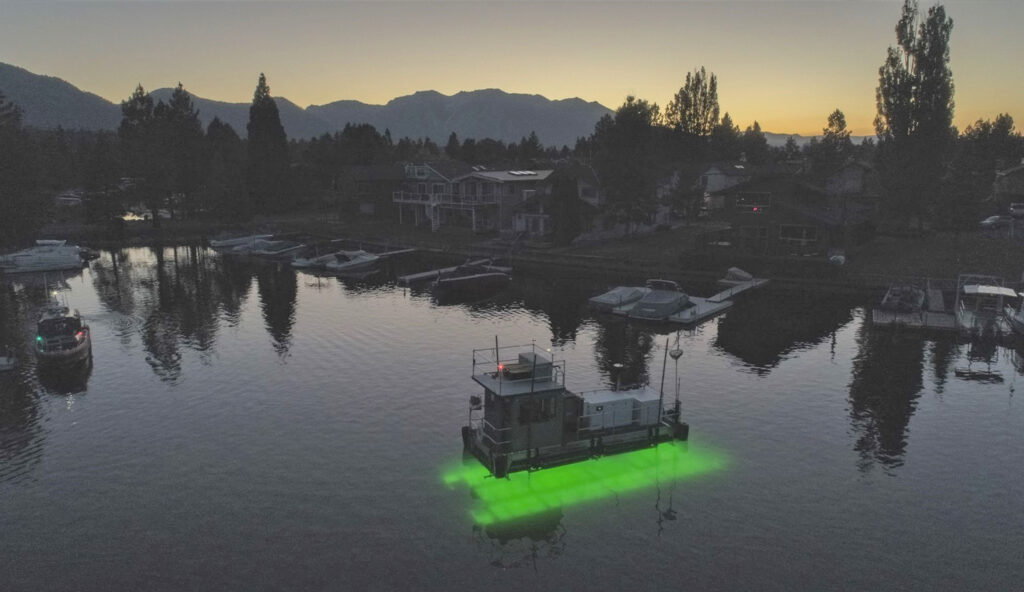
The Tahoe Keys lagoons being treated with UV light. Photo: John Paoluccio, Inventive Resources Inc.
Tackle Invasive Species:
Results from Year Two of Tahoe Keys Control Methods Test
WHAT IS IT?
The Control Methods Test (CMT) is a three-year, science-based program to test a range of treatment methods, alone and in combination, to control the infestation of aquatic invasive weeds in targeted areas within the Tahoe Keys. The results will guide a long-term strategy to tackle Tahoe’s most threatening invasive species infestation, stop its spread further into the Lake, and help protect water quality and clarity lakewide.
WHERE IS IT IN THE PROCESS?
Last September, the Tahoe Keys Property Owners Association (TKPOA) completed the second year of the three-year CMT. In the first year, plant biomass was significantly reduced using an array of methods, including the one-time, targeted use of herbicides behind protective curtains.
In the second year, only non-chemical methods were applied, such as UV light treatment, laminar flow aeration, bottom barriers, and diver-assisted suction harvesting. The goal was to determine if the reduction of invasive weeds, or “knock-back,” achieved in the first year could be maintained. The environmental conditions were radically different in the second year compared to the first, with water levels four feet deeper. This variability had a range of effects and bolsters what we will learn from the CMT in vastly different water conditions.
Scientists analyzed tens of thousands of data points from year two tests, and they have seen the initial knock-back in invasive plant density was largely sustained in herbicide-treated sites and some non-chemical sites. The complete results of the CMT’s second year of tests are complete and publicly available, along with this short summary.
WHAT’S NEXT?
This summer is the final year of the CMT. TKPOA will expand the use and of non-chemical methods, weather-permitting, such as UV light treatment, bottom barriers, and diver-assisted suction harvesting. No herbicides will be applied in 2024.
The results of the CMT will inform long-term management plans for addressing aquatic invasive weeds in the Tahoe Keys so they cannot spread further into the Lake.
WHAT IS THE LEAGUE’S POSITION? SUPPORT
Aquatic invasive species are the single largest ecological threat to Lake Tahoe and must be contained. We support the CMT because the status quo has failed to control the problem; the test will help inform a long-term invasive weed control strategy; and the CMT’s design has a firm foundation in the best available science.
The League has been heavily involved in all aspects of the CMT, from designing the project to funding adaptive management and non-chemical tests. It has been our priority to ensure that the process is guided by and adheres to the best available science to protect Tahoe’s water quality. Our team of experts helped craft the design for the year two tests and are doing the same for year three. While testing is underway, we watch the project closely to ensure it is executed safely and with long-term invasive species control and containment at the forefront.
CLIMATE CONNECTION:
Climate change is creating a more hospitable habitat for aquatic invasive species and harmful algal blooms in Lake Tahoe. Prolonged drought lowers Tahoe’s water level, expanding areas of shallow water that warm easily and allow for invasive weeds to flourish.
MORE INFORMATION:
We’re Keeping an Eye on It:
Upcoming Projects and Programs
MANAGED PARKING:
Breaking Tahoe’s dependence on private automobiles is key to protecting the Lake for future generations. The Tahoe Regional Transportation Plan lays out a path to achieve that goal based on successful examples from around the country. The recipe calls for balancing free and convenient alternative transportation – such as buses, shuttles, bike paths, and pedestrian trails – with paid, or “managed” parking. Managed parking has been implemented in several places around the Lake, and Placer County recently held a series of public meetings to ask for input on its own managed parking plans. Our team is watching closely.


